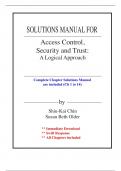SOLUTIONS MANUAL FOR
Access Control,
Security and Trust:
A Logical Approach
Complete Chapter Solutions Manual
are included (Ch 1 to 14)
by
Shiu-Kai Chin
Susan Beth Older
** Immediate Download
** Swift Response
** All Chapters included
,Access Control, Security, and Trust: A Logical Approach Sample Solutions
Chapter 1
Exercise 1.0.1
• The request is to remove books from the library
• The books are being protected
• The guards are the librarians
• The librarians allow books to be removed based on a valid library card (a ticket)
Exercise 1.0.2
• What is being requested includes
– Reading account balances and activities
– Transferring funds to other accounts
• Customer accounts are being protected
• The guards include the website checking userids and passwords
• The decision to grant access is made based on userids and passwords
Exercise 1.0.3
• Guard checking ticket and government issued ID is checking your identity and
if you have a flight leaving the airport that day
• Guard checking bags is checking if you are carrying any objects deemed a secu-
rity threat such as firearms, explosives, etc.
• Ticket agent checking boarding pass is checking if you have an authorized seat
on the flight
Exercise 1.1.1 This is about authenticating legitimate users/credit card holders on
the basis of checking if the internet customer possesses the physical credit card. The
name, account number, expiration date, and security code are aimed at determining
if the internet customer possesses the card. (This is the purpose of asking for the
security code). The assumption is that people who have physical access to the card are
legitimate customers (unless the card is reported as stolen).
2 D O N OT D ISTRIBUTE
, Access Control, Security, and Trust: A Logical Approach Sample Solutions
Chapter 2
Exercise 2.1.1
a. P ({x, y, z}) = {0,
/ {x}, {y}, {z}, {x, y}, {x, z}, {y, z}, {x, y, z}}
b. U(3) = {3, 2}
c. U(4) = 0/
d. T ∪U = {(1, 1), (1, 3), (2, 1), (2, 4), (3, 2)(3, 3), (3, 4), (4, 4)}
e. T ∩U = {(3, 3)}
f. T −U = {(1, 1), (2, 1), (4, 4), (3, 4)}
g. U ◦ T = {(2, 4), (1, 3), (1, 4), (3, 3), (3, 4), (3, 1)}
h. T ◦U = {(1, 3), (2, 3), (3, 3), (3, 2)}
Exercise 2.1.2 Let R, S, T be relations such that R ⊆ S, and consider an arbitrary
element (x, z) ∈ R ◦ T . By definition of ◦, there exists some y such that (x, y) ∈ R and
(y, z) ∈ T . Because R ⊆ S, we know that (x, y) ∈ S. It follows that (x, z) ∈ S ◦T . Because
(x, z) was an arbitrary element of R ◦ T , we have shown that R ◦ T ⊆ S ◦ T .
Exercise 2.1.3 Consider arbitrary relations R, S, T . Our analysis involves two steps:
1. Consider an arbitrary element (x, z) of (R ∪ S) ◦ T ; by definition of ◦, there exists
y such that
(x, y) ∈ R ∪ S, (y, z) ∈ T.
Because (x, y) ∈ R ∪ S, either (x, y) ∈ R (in which case (x, z) ∈ R ◦ T ) or (x, y) ∈ S
(in which case (x, z) ∈ S ◦ T ). In either case, (x, z) ∈ (R ◦ T ) ∪ (S ◦ T ).
Because (x, z) was arbitrary, (R ∪ S) ◦ T ⊆ (R ◦ T ) ∪ (S ◦ T ).
2. Consider an arbitrary element (x, z) of (R ◦ T ) ∪ (S ◦ T ). It follows that (x, z) is
an element of R ◦ T or S ◦ T (or both); without loss of generality, assume that
(x, z) ∈ R ◦ T . By the definition of ◦, there exists some y such that (x, y) ∈ R and
(y, z) ∈ T .
Because (x, y) ∈ R, we also know that (x, y) ∈ R∪S, and hence (x, z) ∈ (R∪S)◦T .
Because (x, z) was arbitrary, (R ◦ T ) ∪ (S ◦ T ) ⊆ (R ∪ S) ◦ T .
Having demonstrated that each set is a subset of the other, we have shown that
(R ∪ S) ◦ T = (R ◦ T ) ∪ (S ◦ T ).
3 D O N OT D ISTRIBUTE




